
Poeciliidae are a family of freshwater ray-finned fishes of the order Cyprinodontiformes, the tooth-carps, and include well-known live-bearing aquarium fish, such as the guppy, molly, platy, and swordtail. The original distribution of the family was the Southeastern United States to north of Río de la Plata, Argentina, and Africa, including Madagascar. Due to release of aquarium specimens and the widespread use of species of the genera Poecilia and Gambusia for mosquito control, though, poeciliids can today be found in all tropical and subtropical areas of the world. In addition, Poecilia and Gambusia specimens have been identified in hot springs pools as far north as Banff, Alberta.

Poecilia is a genus of fishes in the family Poeciliidae of the order Cyprinodontiformes. These livebearers are native to fresh, brackish and salt water in the Americas, and some species in the genus are euryhaline. A few have adapted to living in waters that contain high levels of toxic hydrogen sulfide and a population of P. mexicana lives in caves.
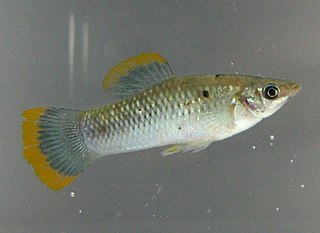
Poecilia sphenops, called the Mexican molly or simply the molly, is a species of poeciliid fish from Central America. It was once understood as a widespread species with numerous local variants ranging from Mexico to Venezuela, but these variants are today considered distinct species belonging to the P. sphenops complex and P. sphenops itself as being native to Mexico, Guatemala, and Honduras. Due in part to its popularity as an aquarium fish, the species has been introduced outside of its native range, but many records may in fact refer to P. mexicana or other species from the complex. P. sphenops has been crossbred with other mollies, notably P. latipinna and P. velifera, to produce fancy mollies for the ornamental fish trade.

Jenynsia is a genus of freshwater fishes in the family Anablepidae. Like Anableps species, they are onesided livebearers: some sources indicate that they only mate on one side, right-"handed" males with left-"handed" females and vice versa. However, other sources dispute this. These South American fish are viviparous.

Poecilia wingei, known to aquarists as Endlers or Endler's livebearer, in the genus Poecilia, is a small fish native to the Paria Peninsula in Venezuela. They are prolific breeders and often hybridize with guppies. These very colorful hybrids are the easiest to find being offered in pet-shops, typically under the name Endler's guppy.

Limia is a genus of livebearing fishes belonging to the Cyprinodontiform family Poeciliidae. It comprises 22 described species found in fresh, brackish, saltwater, and hypersaline habitats of the Greater Antilles islands in the Caribbean Sea. A vast majority are endemic to Hispaniola. There has been a long-running debate on whether Limia should be considered a subgenus of Poecilia rather than a full genus. Most Limia species are detrivores and herbivores. Due to their small size and coloring, they are sometimes kept in home aquaria.
John Arthur Endler is a Canadian ethologist and evolutionary biologist noted for his work on the adaptation of vertebrates to their unique perceptual environments, and the ways in which animal sensory capacities and colour patterns co-evolve.
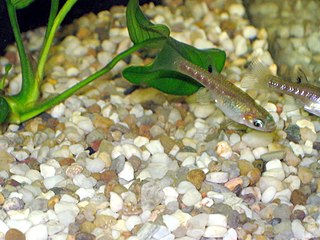
Girardinus is a genus of poeciliids native to Cuba. The name of this genus honours the French zoologist Charles Frédéric Girard (1822-1895) for his work on the freshwater fish of North America.
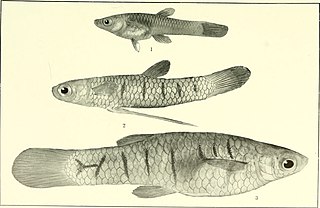
Pamphorichthys is a genus of poeciliids native to the Amazon, Paraguay, São Francisco and Itapicuru basins in South America.
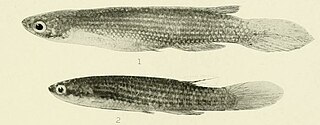
Anablepsoides is a genus of killifish in the family Rivulidae native to tropical South America and the Lesser Antilles. The majority are from the Amazon and Orinoco basins, as well as freshwater systems in the Guiana Shield, but a few species are from northern Venezuela, northeastern Brazil and the Lesser Antilles. Although largely restricted to lowlands, a few species occur in the lower East Andean foothills. They are mostly found in shallow fresh water swamps, streams, edges of rivers, ponds and pools, but a few may occur in brackish estuaries. They are able to jump over land and breathe air for short periods, allowing them to access isolated waters inhabited by few or no other fish. Several Anablepsoides species have small distributions and some are seriously threatened by habitat loss; the entire known range of A. xinguensis is in the area flooded by the Belo Monte Dam.

Laimosemion is a genus of fish in the family Rivulidae from the Amazon basin and basins in the Guiana Shield in tropical South America. They mostly inhabit small streams, creeks, swamps and pools in lowlands, but locally occur to an altitude of 1,300 m (4,300 ft).
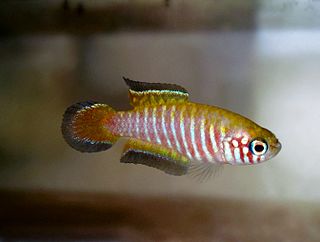
Simpsonichthys is a genus of killifish from the family Rivulidae the species of which are endemic to temporary freshwater habitats like ponds in the upper Paraná, upper Araguaia, upper Jequitinhonha and São Francisco basins on the central Brazilian Plateau. They are small annual killifish that reach up to 5.5 cm (2.2 in) in standard length.

Spectrolebias is a genus of killifish in the family Rivulidae. These annual killifish are endemic to seasonal waters in the Paraguay, Tocantins–Araguaia, Xingu and Mamoré–Grande basins in Bolivia, Brazil and Paraguay. Each species generally has a small distribution and some are seriously threatened by habitat loss; the entire known range of S. reticulatus is in the area flooded by the Belo Monte Dam.

Poeciliinae is a subfamily of killifish from the family Poeciliidae which contains species from the Americas which are collectively known as the livebearers because many, but not all, of the species within the subfamily are ovoviviparous.
Limia melanonotata, the blackbanded limia, is a toothcarp in the family Poeciliidae. It is endemic to the island of Hispaniola.

Procatopodinae is a subfamily of the family Poeciliidae, the "livebearers", in the order Cyprinodontiformes. Some authorities treat this subfamily as a family, the Procatopodidae, including the banded lampeye.

Poecilia parae, also known as the melanzona guppy, is a species of fish from the family Poeciliidae which is found in northern South America from Guyana to the mouth of the Amazon River.

Poecilia kykesis, also known as the Usumacinta molly, Petén molly, spiketail molly, or swordtail molly, is a poeciliid fish species native to the fresh and brackish waters of Mexico, Guatemala, and Belize. It belongs to the sailfin molly clade, with males exhibiting an enlarged dorsal fin. The species has a notably controversial naming history, with the former name, Poecilia petenensis, now referring to a short-finned molly species. It is a livebearer sometimes kept in aquaria.

Poecilia vivipara, sometimes called the southern molly, is a small euryhaline livebearer fish distributed along the Atlantic coast of South America. It is most frequently found in standing brackish water. It has been introduced outside its native range to control mosquito populations and is occasionally kept in home aquariums.

Poecilia picta, the swamp guppy, is a species of livebearer fish found in South America. It is closely related to the common guppy, P. reticulata, and shares its geographic range but tends to be found in more brackish environments.


















